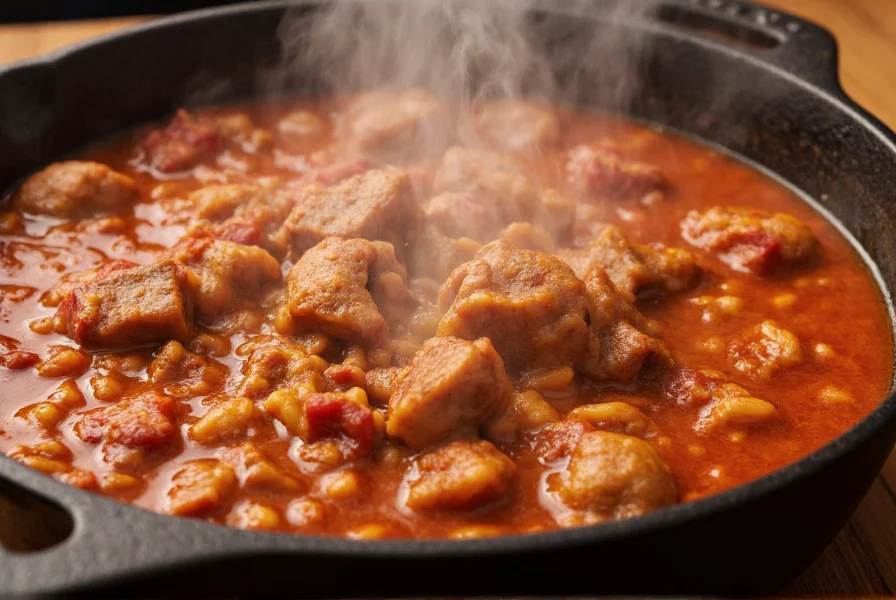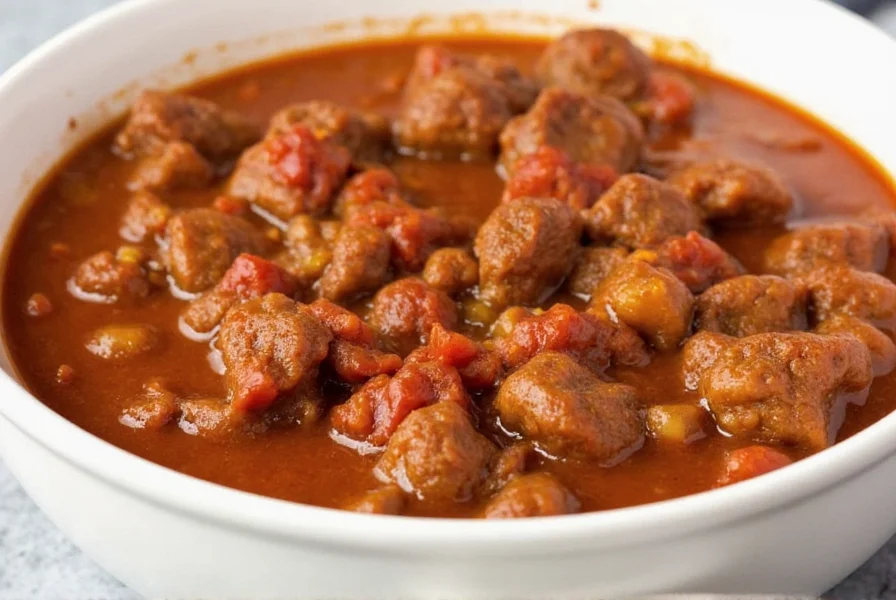Creating exceptional pork chili starts with selecting quality ingredients and understanding the science behind flavor development. Unlike traditional beef chili, pork's natural sweetness balances beautifully with smoky spices and acidic tomatoes. This comprehensive guide delivers a foolproof method for making restaurant-quality pork chili at home, with insights you won't find in basic recipe searches.

The Essential Pork Chili Ingredients
Quality ingredients form the foundation of any outstanding pork chili recipe. While substitutions exist, certain elements are non-negotiable for authentic flavor development.
| Ingredient | Quantity | Preparation Notes |
|---|---|---|
| Pork shoulder (boneless) | 2 lbs | Cut into 1-inch cubes, fat partially trimmed |
| Chili powder | 3 tbsp | Use a blend containing ancho and chipotle |
| Fire-roasted tomatoes | 1 (28 oz) can | Do not drain |
| Black beans | 1 (15 oz) can | Rinsed and drained |
| Beef or pork broth | 2 cups | Low sodium preferred |
| Yellow onion | 1 large | Finely diced |
| Garlic cloves | 4 | Minced |
Step-by-Step Pork Chili Preparation
Follow this professional technique for maximum flavor extraction and perfect texture. The key difference between adequate and exceptional pork chili lies in the cooking methodology.
1. Searing the Pork
Pat pork cubes dry with paper towels—moisture prevents proper browning. Heat 2 tablespoons of vegetable oil in a heavy-bottomed pot over medium-high heat until shimmering. Working in batches to avoid overcrowding, sear pork on all sides until deeply browned (about 3-4 minutes per side). Transfer to a plate. Proper searing creates the Maillard reaction, developing complex flavor compounds essential for depth.
2. Building Flavor Foundations
In the same pot, add diced onions and cook until translucent (5-7 minutes). Add minced garlic and cook for 1 minute until fragrant. Stir in chili powder, 2 teaspoons cumin, 1 teaspoon smoked paprika, and 1/2 teaspoon cayenne pepper. Cook this spice mixture for 1-2 minutes to toast the spices, releasing their essential oils and intensifying flavor.
3. Simmering to Perfection
Return seared pork to the pot along with any accumulated juices. Add fire-roasted tomatoes (with liquid), broth, and 1 bay leaf. Bring to a gentle boil, then reduce heat to low. Cover and simmer for 2 hours, stirring occasionally. After 2 hours, add rinsed black beans and continue simmering uncovered for 30-60 minutes until pork is fork-tender and chili has thickened to your preferred consistency.

Pro Tips for Exceptional Pork Chili
These professional techniques transform good pork chili into extraordinary:
- Acid balance: Stir in 1 tablespoon of apple cider vinegar during the last 15 minutes of cooking to brighten flavors
- Texture control: For thicker chili, mash some beans against the pot side before adding
- Flavor layering: Add 1 ounce of finely chopped dark chocolate during the last 30 minutes for depth
- Resting period: Let chili sit covered off-heat for 20 minutes before serving to allow flavors to meld
Variations for Different Dietary Needs
Adapt this versatile pork chili recipe to accommodate various preferences without sacrificing flavor:
For slow cooker pork chili, follow steps 1-2, then transfer everything to a slow cooker and cook on low for 6-8 hours. The slow cooking process yields incredibly tender pork with minimal effort.
For spicy pork chili recipe lovers, add 1-2 diced jalapeños with the onions and increase cayenne to 1 teaspoon. For authentic Texas-style pork chili without beans, simply omit the beans and increase broth by 1/2 cup.
Serving and Storage Recommendations
Serve pork chili hot with traditional toppings: sour cream, shredded cheddar, diced red onion, and fresh cilantro. This hearty pork chili recipe pairs perfectly with cornbread or saltine crackers for dipping.
Store leftovers in an airtight container in the refrigerator for up to 4 days. Pork chili actually improves in flavor after 24 hours as spices continue to meld. For longer storage, freeze portions in freezer-safe containers for up to 3 months. Thaw overnight in the refrigerator before reheating gently on the stove with a splash of broth to restore consistency.
Frequently Asked Questions
Can I use ground pork instead of pork shoulder in chili?
Yes, but with important considerations. Ground pork works well but lacks the rich collagen found in pork shoulder that creates natural thickening during slow cooking. If using ground pork, brown it thoroughly and consider adding 1 tablespoon of tomato paste to help with texture. The cooking time reduces to 45-60 minutes since there's no connective tissue to break down.
What's the difference between pork chili and traditional chili?
Pork chili features pork as the primary protein instead of beef, creating a slightly sweeter, more delicate flavor profile. Pork shoulder contains more fat marbling than lean beef cuts, resulting in a naturally richer broth. Traditional chili often uses beef chuck or ground beef, while pork chili benefits from the meat's natural sweetness that pairs exceptionally well with smoky spices and acidic tomatoes.
How do I fix chili that's too spicy?
If your pork chili recipe turns out too spicy, add dairy products like sour cream or shredded cheese which contain casein that binds to capsaicin. Alternatively, stir in 1-2 tablespoons of sugar or honey to counterbalance heat, or add more tomatoes and broth to dilute the spiciness. Never add water alone, as it won't properly address the capsaicin molecules causing the heat.
Can I make this pork chili recipe in an Instant Pot?
Absolutely. For an Instant Pot pork chili recipe, use the sauté function to brown pork and cook onions/garlic. Add remaining ingredients, seal, and cook on high pressure for 25 minutes followed by a 15-minute natural release. The pressure cooking method significantly reduces time while maintaining tenderness, though some chefs argue the slow simmer develops more complex flavors.
What are the best beans for pork chili?
Black beans provide the classic texture and visual contrast in pork chili recipes, but pinto beans offer a creamier texture that blends well with the pork. For authentic flavor, use one type rather than mixing beans. If avoiding beans entirely (as in Texas-style chili), increase the pork quantity by 50% and add an extra 1/2 cup of broth to maintain liquid levels during cooking.











 浙公网安备
33010002000092号
浙公网安备
33010002000092号 浙B2-20120091-4
浙B2-20120091-4